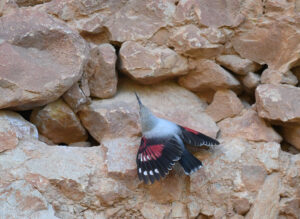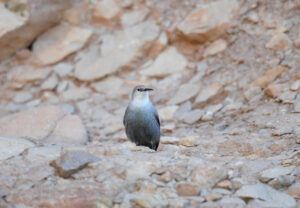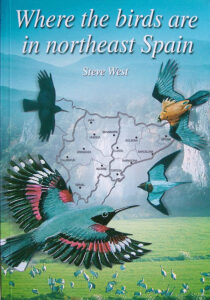Another Wallcreeper Autumn
Wallcreeper magic
The magic of the Wallcreeper needs little introduction to most European birders. The Wallcreeper clings and flits about vertical walls and rock faces, probing its long downcurved bill into nooks and crannies to fish out insects, arachnids and other small invertebrates that form its diet. The Wallcreeper is a very active little bird, that tumbles and climbs, edges along, flits this way and that, and then with for no apparent reason departs with a fluttery, butterfly flight that takes it around the corner and out of your view. Follow it if you can – you can’t.

Wallcreeper on rocks
The Wallcreeper inspires awe and admiration in part because of where it is and what it does to be there, but even so the Wallcreeper wouldn’t be quite the prize that it is without its striking wing markings – those carmine panels and clean white wing spots on a nitid black background – and also, in the relative effort that it takes for the average birder to see one. Wallcreepers don’t grow on trees, and not even on rocks!
In northeast Spain Wallcreepers breed only in the Pyrenees and at altitudes which deter all but the most determined – and fit – to find them. Hence, it is our immense good luck that come the autumn Wallcreepers all but abandon their high mountain haunts and start frequenting places the average birder isn’t so challenged to get to. We have an opportunity to see one, now let’s not waste it!
November is the month I feel most confident about when an eager client approaches me with the request to see a Wallcreeper. Followed by February and March. Why? By November virtually all the Wallcreepers have left their high mountains and descended to rock faces at lower altitudes. To places in the Pre-Pyrenees of Lleida, Huesca and Zaragoza, where they might decide to stay until the food runs out in the depths of winter and it’s time to move on. Then, move on to where? Further south, to another range? Or just around another part of the rock face, somewhere away from prying birders? Either way, the following deep winter period of late December and January corresponds to a time when I find it difficult to predict how reliable the usual wintering sites will be at giving our hungry eyes a feast of the Wallcreeper.

wallcreeper on rocks
But November? November has been generous with its Wallcreepers over the years. And this year has been no exception. With Adam and Daniela we saw no fewer than 5 Wallcreepers in two days, with a maximum of four at one site. Then, in mid-December (I know, but I had my doubts) Eirik and I hit the Wallcreeper jackpot again, this time with 3 Wallcreepers at the same site as the November 4.
What’s more, Adam, Daniela and Eirik were all bird photographers, and it’s my personal belief that bird photographers are never happy with what they have got. “Oh, yes, but the light,” “the background could be better”, “too much contrast,” “not close enough,” “too far away” “I was hoping for an adult bird”… and a long etcetera. So if they all went away happy with their Wallcreeper shots we all must have done something right!

Where the birds are in northeast Spain
Check out the itineraries on the Birding In Spain website to see some of the places where you can find the dazzling Wallcreeper. Or go one step further and buy the book “Where the birds are in northeast Spain“. Or go for the ultimate time saver: ask us to lead you to a Wallcreeper or two in person. Fortunately the Wallcreeper still frequents most of the sites described therein. Then stay here for more to follow on this marvellous bird …
Leave a Reply